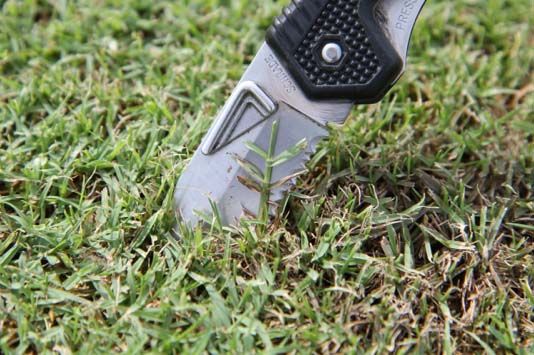Pathogen(s): Bipolaris, Drechslera, and Exserohilum spp. (previously classified as Helminthosporium fungi)
Turfgrasses Affected: All warm-season turfgrasses can be affected, but the disease is usually most serious on bermudagrass. Different species of these fungal pathogens affect different species of turfgrass.
Occurrence: This disease is caused by a group of fungi that is active over a wide range of temperatures. At any given time of the year, at least one species within this fungal group can be isolated. Thus, diseases caused by these fungi can occur at any time of year. However, as a general rule, the leaf spot disease occurs during mild, wet periods during fall and winter months.
Symptoms/Signs: Leaf spot symptoms tend to vary with each pathogen/host pair. Spots range in size from very small (pinhead size), solid brown to purple lesions or spots to expanded lesions with bleached centers that girdle the leaf blade (Figure 1). Severely infected leaves turn purple or reddish brown in color, giving the turf an overall purple cast. Severely infected leaves eventually wither and dry to a light tan color. Lesions on stolons are dark purple to black. Distinct patches or patterns to the disease are usually not obvious. In cases of severe infection, turf areas thin and die.

Cultural Controls: Proper nutrient management can reduce the risk of Helminthosporiium leaf spot disease. Excess nitrogen during potential disease development periods should be avoided. The nitrogen level must be balanced with potassium at a recommended ratio of 1:2 (N:K). In areas that are affected routinely by this disease, the potassium level should be increased before the disease normally occurs. Slow-release potassium sources or frequent applications of quick-release potassium sources are suitable for use. Mowing height should be raised during disease outbreaks.
Chemical Controls: Fungicide options include , chlorothalonil, fludioxonil, iprodione, mancozeb, myclobutanil, propiconazole, pyraclostrobin, trifloxystrobin, triticonazole, and vinclozolin.
The UF/IFAS Extension Electronic Data Information Source (EDIS) website can be referenced for a homeowner's guide to turfgrass fungicides (https://edis.ifas.ufl.edu/publication/pp154). Fungicide labels indicate site application restrictions, as some fungicides cannot be used on residential lawns. Label directions and restrictions for all pesticides should be followed as required by law. Caution should be exercised, as DMI (demethylation-inhibiting) fungicides have shown the potential to damage bermudagrass turf. The presence of a fungicide on this list does not constitute a recommendation.
The "Turfgrass Disease Management" section of the Florida Lawn Handbook (https://edis.ifas.ufl.edu/lh040) can be referenced for explanations of cultural and chemical controls.